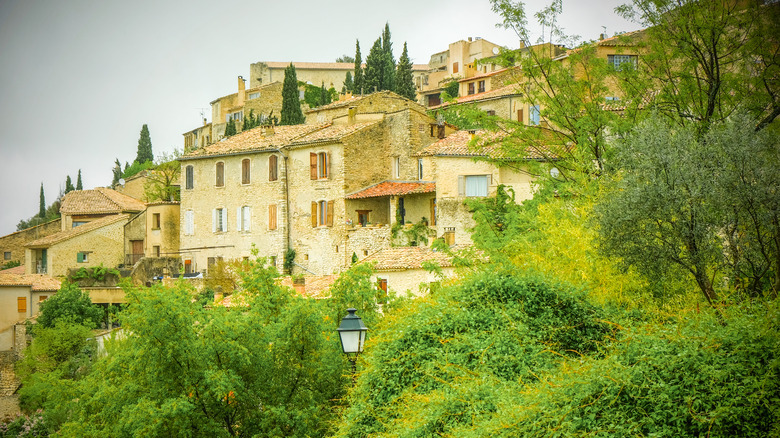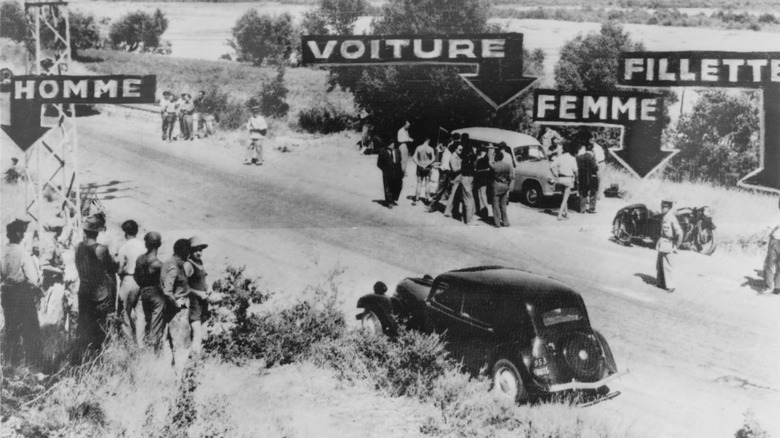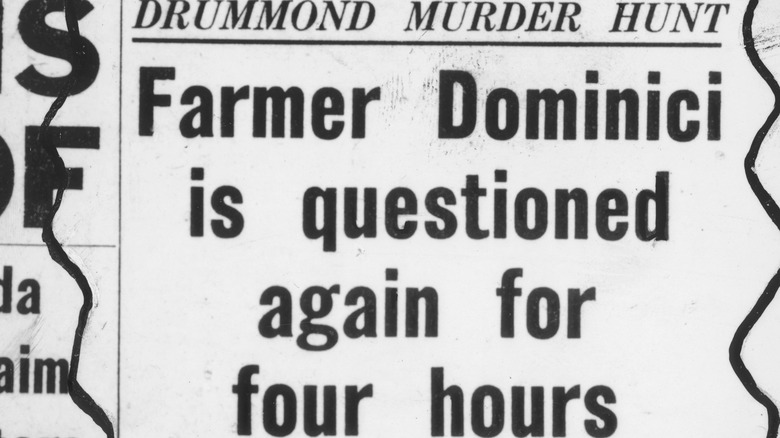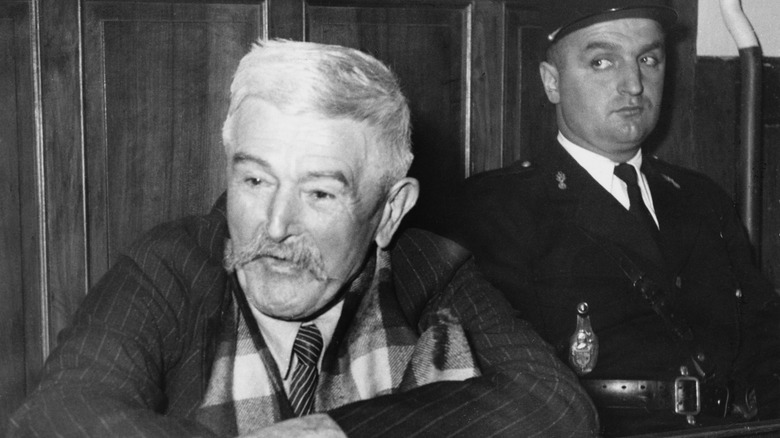The 1952 Triple Homicide And Controversial Investigation Behind The Dominici Affair
Early in the morning of August 5, 1952, on a country lane near the French village of Lurs, a factory worker was driving home from a night shift when a young man frantically waved him down. The driver stopped, and the boy told him he'd found a dead body. When the gendarmes arrived, they found a woman named Lady Anne Drummond. Her husband, the scientist Sir Jack Drummond, and their 10-year-old daughter Elizabeth lay nearby, also dead.
This, according to The Guardian's account, was the first act of one of the most mysterious and vexing murder cases in French history. Three English tourists, one of them fairly well-known, would be murdered in a field. Witness testimony would be baffling and contradictory. A local peasant would be accused and sentenced to the guillotine, only to be later pardoned. A prisoner in another country would hint that he was involved. Many untold secrets lurk in this story's shadows.
The Drummonds in France
Let's start with what we do know. According to The Guardian's exhaustive account and other sources, the Drummond family, of Nottingham, were to spend their summer holiday in Villefranche-sur-Mer, near Nice, with a family friend. Sir Jack was a nutritionist and researcher, knighted for his work promoting healthy diets during Britain's wartime rationing. They were otherwise quite an ordinary middle-class family.
They left home on July 25, 1953, and drove via the Dunkirk ferry to Villefranche. On August 4, the family drove to the town of Digne to see a bullfight. Someone overheard Sir Jack mention that, given the nice weather, they could camp that night on their way back to Villefranche. (He was, according to the Mirror, an "experienced camper.") They never made it back. The next morning the factory worker, alerted by the boy, would speed off to find the police.
The gendarmes would find all three bodies dead on the roadside. (The above map, from a contemporary newspaper, shows where the man, woman, girl, and their car were found.) The 61-year-old Sir Jack had been shot, literally, to pieces; part of his hand was left on the car's bumper where he'd struggled to get up. Lady Drummond had also been shot, then covered with a blanket. Elizabeth, in pajamas, seemed to have been clubbed to death. The car had been rummaged through, but nothing had been taken.
Gaston Dominici
The Guardian and The New York Times recount that the point in the road where the Drummonds were found abutted the property of a well-to-do farmer named Gaston Dominici. Dominici, 77, was a respectable pater familias, largely retired from the physical work of farming hay and olives, which his many sons still carried out. One of these sons, Gustave, was the boy who had flagged down the car that early morning of August 5.
Police questioned Dominici about the night in question. People in the house had heard gunshots around 1 a.m., he said, but no one thought much of it; late-night poaching was common in those parts. But the detectives began to notice strange inconsistencies in Dominici's story. It turned out that the Drummonds had stopped by the Dominici farmhouse for water the day before. Worse, at one point old Dominici mentioned Lady Drummond "died instantly." How could he have known?
All the Dominici sons were called in for questioning, separately, in the days that followed. Young Gustave and his brother Clovis would both claim to have heard the Drummonds scream. Gustave had gone down to look at the bodies and confirm whether the bullet casings were his father's. Both said that their old father had come home that night and announced, "I have killed the English."
A tale of lust?
The old farmer (above, left) would finally confess that he had murdered the Drummonds. It was a tale of lust, he said. According to The Guardian, he claimed he had gone down in the night to spy on the camping family, having seen that Lady Drummond was an attractive woman. He watched her undress, then presented himself quietly; she posed no objection to his overtures. Sir Jack woke up, hearing the two make love, and charged them. Dominici shot him with his hunting rifle in a panic. The wife and daughter started screaming, so he finished them off as well.
It was an impossible story, though. The wounds he described inflicting did not match the bodies at all, and the story of the 77-year-old farmer (who walked with a cane, The Guardian notes, and used a bit of rope for a belt; the Times called him "gnarled") expertly seducing a much younger foreign lady beside her husband and daughter seemed rather a stretch. A few days later, Dominici recanted, claiming he was trying to protect his family; later he would say that he'd seen young Gustave dragging Elizabeth's body into a hay field. Gustave recanted as well, saying he'd been bullied into a confession. Clovis remained firm. The court would find old Dominici guilty, and sentence him to death by guillotine.
A faulty investigation
Dominici was lucky: Charles De Gaulle, then president of France, pardoned him (via The New York Times). Something seemed off about this case and Dominici's guilt. For one thing, Dominici had mimed to the police the action of shooting and reloading, shooting and reloading a gun, as one would a single-shot hunting shotgun. The Drummonds had been killed by automatic rifle, as the police knew well. Even the investigation itself was suspicious. The Guardian lists a number of the questionable tactics of the investigators in Lurs. When they found pieces of a broken rifle butt that matched the blunt force trauma on Elizabeth's head, it was handled with bare hands and never even tested for fingerprints. They also never taped off the crime scene, which was soon overrun by reporters and curious neighbors. The piece of Sir Jack's hand found on the car should have gone in for tests; somehow, it got lost.
The Guardian hints darkly that the top investigator of Marseille, who had been called up to Lurs to handle the case, had a grudge against the Dominici clan: they belonged to rival political parties. Later writers would find that the investigator apparently lied about other evidence: footprints that clearly matched none of the victims, nor any of the Dominici men, were written off as unimportant.
The dark twist
Amateur historians have found some tantalizing, and mysterious, evidence of something rotten in the heart of this case. Writer Raymond Badin, quoted by The Guardian, notes that Sir Jack had been to the village of Lurs three times before his fatal trip. There was a chemical factory near the town; Gizmodo connects the dots to implicate defoliants Agent Orange. According to what Badin told The Guardian, "Jack Drummond, we are almost certain, was a spy." But were he and his family killed by enemy spies?
William Reymond, who wrote a book with Gustave Domini's son Alain, claims to have found evidence for something far more sinister (via The Guardian). According to Reymond, a German criminal, serving time, claimed to have been hired by three shifty foreigners to drive them from West Germany to the south of France. He thought he was to be the getaway driver for a jewel heist. At a certain stretch of the road, early one morning, the three foreigners made him pull over. They got out and crept into the darkness. The man heard gunshots and screams. When they got back in, they told him they'd killed an English scientist.
The German could describe the landscape of Lurs from memory, and declassified English intelligence documents show that he and three suspects, all linked vaguely with the Russian KGB, had all been arrested by 1965 for the murder of the Drummonds'. France refused to extradite them. If the Drummonds' murder goes unsolved, it is most likely because someone wanted it that way.





